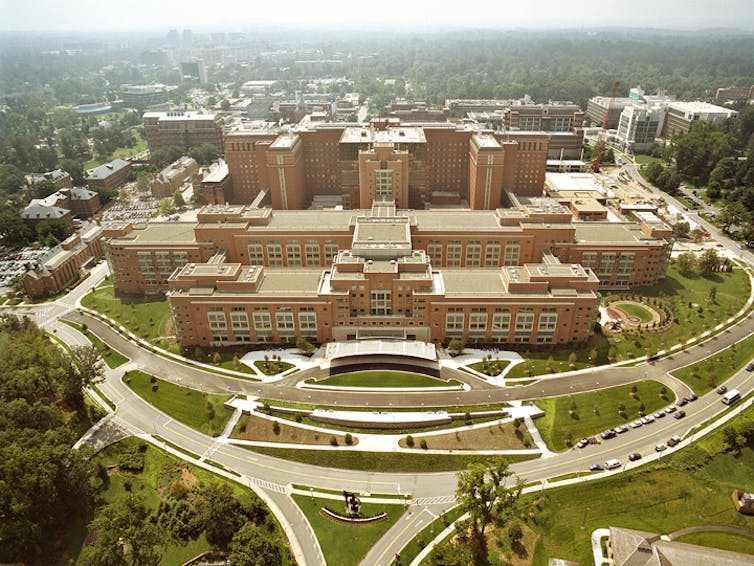
ARPA-H: High-risk, high-reward health research is the mandate of new, billion-dollar US agency

Tong Sun, University of Washington
A new multibillion-dollar federal agency was created with a goal of supporting “the next generation of moonshots for health” in science, logistics, diversity and equality. And the agency now has it’s first leader, as President Joe Biden announced Renee Wegrzyn as director of the Advanced Research Projects Agency for Health, or ARPA-H, on Sept. 12, 2022.
Since the announcement of the intention to establish ARPA-H two years ago, this new agency has sparked interest and questions within both academia and industry.
I have been a director of innovation-driven health institutes for decades and have worked with many of the government agencies that fund science. I and many of my colleagues hope ARPA-H will become an agency that can quickly turn scientific discoveries into real-world advances to detect, prevent and treat diseases like cancer, diabetes and Alzheimer’s. But questions still remain surrounding how it will work and what makes it different from other government-funded agencies such as the National Institutes of Health and the National Science Foundation.

What is ARPA-H?
ARPA-H is the newest entity established within the National Institutes of Health. ARPA-H was explicitly set up as an independent agency within NIH, in theory allowing it to benefit from the NIH’s vast scientific and administrative expertise and resources while still being nimble and forward-thinking.
ARPA-H was inspired by and modeled after the Defense Advanced Research Projects Agency, or DARPA, to rapidly develop cutting-edge technologies. DARPA is small compared to other federal research and development agencies, but has long been hugely successful. It played a critical role in spawning many technologies ranging from the internet to GPS, and even funded Moderna to develop mRNA vaccine technology in 2013.
ARPA-H is not the only DARPA spinoff. In 2006, the federal government created the Intelligence Advanced Research Projects Activity to tackle difficult challenges in the intelligence community, and in 2009, the Advanced Research Projects Agency for Energy was launched. Though its budget is small compared to the Department of Energy, ARPA-E has been incredibly effective in funding ambitious research into fighting climate change. By funding ambitious mid- and long-term projects, IARPA, ARPA-E and now ARPA-H are meant to operate in between slow, government-funded basic research and short-term, profit-driven private sector venture capital.

How will the agency function?
Biden wants ARPA-H to replicate the success of DARPA, but in the health care realm, by providing “leadership for high-risk, high-reward biomedical and health research to speed application and implementation of health breakthroughs equitably.”
Established federal agencies like the NIH and the National Science Foundation prefer to fund more basic research and less risky projects compared to the high-risk, high-reward, applied science approach of DARPA. If ARPA-H wants to achieve the success of its predecessor, it will need to operate differently from NIH and NSF.
DARPA employs about 100 program managers who are “borrowed” from academia or industry for three to five years. These managers travel across the nation to meet with scientists and experts in different fields in order to generate ideas and start projects. These managers make funding decisions and work closely with their funded teams to overcome problems, but will cut funding if teams cannot deliver promised milestones on time. Many DARPA projects don’t produce spectacular successes, yet they pushed the boundaries of science and technology.
Many years ago, I had the privilege of working with a DARPA program manager alongside numerous experts in various scientific and medical fields. After several months of meetings, the program manager came up with the idea to develop “fracture putty” – a puttylike material that could be applied to the shattered bones of a wounded soldier in the battlefield. The material would support weight, prevent infection, expedite healing and bone regeneration and eventually dissolve away. The program launched in 2008, and our team of chemists, nanomaterials experts, bioengineers, mathematical modelers and surgeons was one of the funded teams in this program.

Who is the new director?
Wegrzyn holds a Ph.D. in molecular biology and bioengineering from Georgia Tech. She is currently a vice president of business development at Ginkgo Bioworks, a U.S. biotech company. Wegrzyn spent four and half years as a program manager in DARPA’s Biological Technologies Office, where she managed projects that focused on using genetic engineering and gene editing for biosecurity and public health. She also worked for another DARPA-inspired agency, Intelligence Advanced Research Projects Activity.
At this moment, we don’t know yet the exact plan and progress in hiring APAR-H program managers and where APAR-H’s headquarters will be located. Several cities have expressed interest..
What should people look for as ARPA-H gets started?
DARPA is driven by talented, ambitious and risk-taking program managers. They are the ones who generate ideas and turn lofty goals into executable projects. It will be interesting to see how many and what kind of program managers ARPA-H hires in its early days, as these decisions will give an indication of which areas within health care the agency will be prioritizing.
I’ll also be watching to see how well ARPA-H and its program managers work within the NIH, which has an unbelievable depth of resources and expertise in all health care related fields that ARPA-H can tap into. But the NIH has very different funding mechanisms and culture from DARPA.
The final question is money. Biden wants US$6.5 billion in funding for ARPA-H, and he’s only gotten $1 billion from Congress so far. This is its first, biggest challenge. Finding political unity for funding may have to be this new agency’s first big breakthrough if it is to reach its goals.![]()
Tong Sun, Assistant Dean of Translational Health Sciences, University of Washington
This article is republished from The Conversation under a Creative Commons license. Read the original article.

















